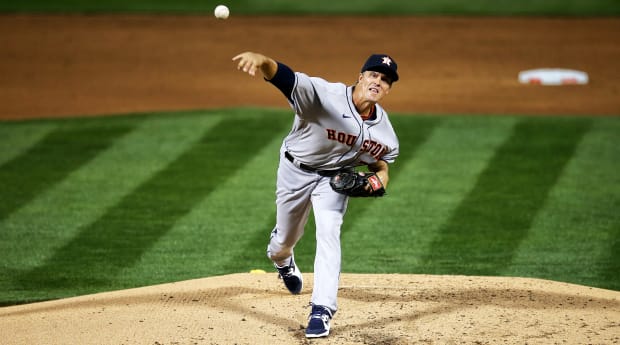Outliers in the modern game, Verlander, Scherzer, Greinke and Kershaw are eligible for free agency after this season.
Welcome to The Opener, where every weekday morning you’ll get a fresh, topical column to start your day from one of SI.com’s MLB writers.
The first pitch Zack Greinke threw on Opening Day was an 87-mph fastball. Mark Canha of Oakland fouled it off. Greinke threw 81 more pitches, only one of which cracked 91 mph. He has not hit 93—the average MLB velocity—since Sept. 20, 2019.
So began another pitching clinic. Averaging 88.6 mph with his fastball, Greinke flummoxed Oakland over six scoreless innings without a walk by mixing his fastball, curve, changeup and slider with surgical precision.
Embedded in that outing was a lesson about not just the craft of pitching, but also the upcoming free agent market. Shortstops will dominate the upcoming free agent class, even with Francisco Lindor staying put with the Mets. But what might be even more fascinating is what will happen to four Hall of Fame pitchers.
There are four active pitchers with 2,500 career strikeouts. They all make $30 million per year. They also are the only four active starting pitchers who are virtual locks for the Hall. They all are eligible for free agency.

Justin Verlander, 38, Max Scherzer, 36, Greinke, 37, and Clayton Kershaw, 33, have seen over the arc of their careers how the game devalued starting pitchers. Complete games withered. Five days of rest became the norm. Third Time Around dictated pitching changes. Pitch counts declined. More work and decisions went to bullpens.
These four are not just survivors. They defy time and trends. As recently as 2004 the idea of a productive starting pitcher 37 and older was routine. That season 11 of them threw at least 162 innings. But over the past three full seasons, only three such veteran pitchers have done so (Adam Wainwright, R.A. Dickey and John Lackey).
Verlander, Scherzer, Greinke and Kershaw are outliers. All appear to have more in the tank and should be in demand on the market, regardless of age. Verlander is recovering from Tommy John surgery in September 2020, which should put him at full tilt for Opening Day 2022. His elbow finally gave out after he threw 258 1/3 innings in 2019, and an average of 244 per year over his ages 34-36 seasons. It was the best stretch of his career.
Coming off a two-year, $66 million deal, Verlander will be in demand, whether that is a return to Houston, a homecoming in Detroit or as a finishing piece for a large market team trying to win the World Series.
Scherzer in Washington joined Randy Johnson with Arizona and Greg Maddux in Atlanta as one of the best free agent pitching acquisitions. In the first six years of his seven-year, $210 million deal, Scherzer was 84-43 with a 2.80 ERA, 186 innings per year, a top five Cy Young finish in all five full seasons and a World Series championship.
Like many pitchers in an evolving game, Scherzer has become less reliant on his fastball in Washington, reducing its use over six years there from 53% to 46% (with losing just about nothing off velocity, by the way). His secondary pitches are extraordinary, as well as his famous competitiveness, which bode well for continued success.
Greinke is reaching the end of the six-year, $206.5 million deal he signed with Arizona. He has been extremely durable throughout his career, reaching 200 innings nine times. He long ago transitioned into a better pitcher as he lost velocity. Since 2011, Greinke is 149-59 with a 3.09 ERA; before that he was 60-67 with a 3.82 ERA. His elite athleticism has served him well in regard to his ability to repeat his mechanics.
Kershaw is the youngest of the quartet, and like Greinke has successfully transitioned into a finesse pitcher who relies on breaking pitches more than any other starter. Kershaw is in trouble when he does not have his usual pinpoint slider, which happened on Opening Day when he gave up 10 hits in Colorado. He threw a whopping 46% sliders (which is hard to do at altitude) and managed only three swings and misses off the pitch.
Kershaw won’t be signing with the Rockies, but he could be an option for his hometown Texas Rangers if the Dodgers are not bound to make sure he never pitches for another organization. He needs extra rest and no longer is a 200-inning pitcher—he averaged 166 in four full seasons since turning 28—but Kershaw’s command and competitiveness remain elite.
Verlander, Scherzer, Greinke and Kershaw may not see six- and seven-year deals again. But that only means they could be options for many teams on short-term deals, especially in a class that is not especially deep in free agent starting pitching (Kevin Gausman, Lance Lynn, Eduardo Rodriguez, Marcus Stroman, Noah Syndergaard). The game may be getting younger and starting pitchers may be getting less work, but these four still represent elite options.

Post a Comment
Thanks For Comment We Will Get You Back Soon.